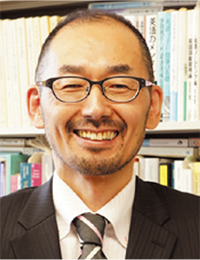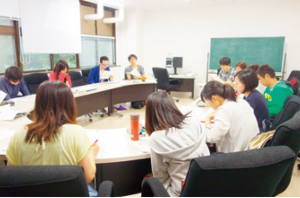星野 由子、清水 遥、長谷川 佑介、木村 雪乃、濱田 明、細田 雅也、森 好紳
キーワード: 英語教育学、応用言語学、言語習得、教授法、外国語としての英語教育
http://www.u.tsukuba.ac.jp/~ushiro.yuji.gn/
 グローバリゼーションの発展、日本企業の海外進出に伴い、社会人に対する英語(英語力)の必要性を求める声は日に日に高まっています。一方で、学校教育、自主的・生涯学習を経てなお英語に悩む日本人は少なくありません。英語を外国語として習得することには、母語話者による第一言語習得のプロセスとどのような違いや共通点があるのでしょうか。外国語習得のメカニズムの解明をつうじ、英語の教授方法とより普遍的な理論の究明に取り組んでいるのが「英語教育学:理論と実践の統合」リサーチユニットです。
グローバリゼーションの発展、日本企業の海外進出に伴い、社会人に対する英語(英語力)の必要性を求める声は日に日に高まっています。一方で、学校教育、自主的・生涯学習を経てなお英語に悩む日本人は少なくありません。英語を外国語として習得することには、母語話者による第一言語習得のプロセスとどのような違いや共通点があるのでしょうか。外国語習得のメカニズムの解明をつうじ、英語の教授方法とより普遍的な理論の究明に取り組んでいるのが「英語教育学:理論と実践の統合」リサーチユニットです。
外国語を読解するうえで欠かせない「破綻」と「修復」プロセス

図1:英語教育学:理論と実践の統合の概念図
日本人は、よく英語が苦手と言われます。母語話者による第一言語習得のプロセスと外国語習得のメカニズムの比較をつうじた研究から私たちが注目しているのが、日本人学習者の英語リーディングにおける「英文理解の破綻と修復プロセス」(図1)です。日本人学習者の一貫した英文理解には、理解の破綻を検知する「破綻プロセス」と、一度生じた破綻を修復する「修復プロセス」が密接に関係していますが、従来の研究ではある一時点だけを切り取って検討していたため、このプロセスが明らかにできていませんでした。私たちのリサーチユニットでは眼球運動測定法(図2)に基づく多角的な検証を行うことで「破綻プロセス」と「修復プロセス」に伴う流動的な読解プロセスがだんだんと明らかになってきました。

図2:眼球運動測定の風景
英語教育学は理論と実践を統合する学問

図3:毎週行われる研究ゼミ
また、教育的介入方法としてコミュニケーションの必要性を伴う読解タスクの導入も行っており、一貫性を維持しながら英文全体を適切に理解できる自律した読み手を育成する方法や学習者の習熟状況や読解のタイプに応じた効果的かつ具体的な英語リーディング指導法についても検討しています。英語教育学は理論と実践を統合する学問です。授業実践を行うにあたっては、理論が真摯に教室現場の実践から学び、実践では理論に裏付けされた確かな提案を行っていく努力が必要不可欠です。本リサーチユニットでは、各構成員だけでなく、ユニットの理念に共鳴した多くの大学院生を研究の関心をひとつに統合することにより、外国語習得のメカニズム解明と教授方法および理論の究明に挑戦しています(図3)。
社会への貢献・実績
● 都道府県教委・市町村教委主催による現職教員研修の実施
● 文部科学省検定済み中学校・高等学校教科書および大学テキストの編集
● 電子辞書検索の技術研究と電子辞書セミナーの実施
● 中・高連携を企図したタスク分析に基づくライティングのシラバス開発
● 再話課題により自分の意見を述べる指導法とテスト開発
● ビデオ活用プレゼンテーションやインスタントテキストフィードバックシステム構築
取材:平成27年7月7日
Learning seriously from actual educational settings to practice evidence-based education
Unit members : Hijikata, Yuko Kubota Akira Hirai, Akiyo Ono, Yuichi
Unit name:English Language Education: The Integration of Theory and Practice
Key words: English education, applied linguistics, language acquisition, teaching methods, teaching English as a foreign language
 As globalization advances and larger numbers of Japanese companies expand overseas, it has become increasingly important for working adults to improve their English skills. However, many Japanese people who have undergone English education in school, or even those who are continuing to study it voluntarily or through lifelong learning courses, are worried about learning English. What are differences and similarities between the process of learning English as a foreign language and that used by native speakers to learn it as the primary language? The research unit: “English Language Education: The Integration of Theory and Practice”, conducts research on the mechanism of learning foreign languages to develop English teaching methods and more universal theories.
As globalization advances and larger numbers of Japanese companies expand overseas, it has become increasingly important for working adults to improve their English skills. However, many Japanese people who have undergone English education in school, or even those who are continuing to study it voluntarily or through lifelong learning courses, are worried about learning English. What are differences and similarities between the process of learning English as a foreign language and that used by native speakers to learn it as the primary language? The research unit: “English Language Education: The Integration of Theory and Practice”, conducts research on the mechanism of learning foreign languages to develop English teaching methods and more universal theories.
Processes of “collapse” and “restoration” essential for the reading comprehension of foreign languages
It is believed that Japanese people are not good at English. We conduct research to compare the process used by native English speakers to learn it as the primary language and the mechanism of learning foreign languages, focusing on the “processes of collapse and restoration in English sentence comprehension” in relation to the English reading skills of Japanese learners (Figure 1). Consistent understanding of English sentences by Japanese learners is closely related to the “process of collapse”, in which the collapse of consistency is identified, and the “process of restoration”, in which collapsed understanding is restored. Previous studies, which focused on only part of these processes, failed to clarify them. Multifaceted analyses based on the eye movement measurement method (Figure 2) conducted by the research unit have gradually clarified the fluid process of reading comprehension, which is associated with the “processes of collapse and restoration”.

Figure 2: A scene of eye movement measurement
English education as an academic discipline that has integrated theories and practice

Figure 3: A research seminar held weekly
Furthermore, we are developing: an educational intervention involving reading-comprehension tasks, which require communication skills; a method for training independent-minded readers with the ability to properly understand whole English sentences while maintaining their consistency; and effective and specific methods to teach English reading according to the learning level of learners and their reading comprehension type. English education is an academic discipline that integrates theories and practice. The implementation of school classes requires theories that have incorporated what is learned from actual classes and practical suggestions based on theories. The research unit integrates the research interests of both its members and other graduate students who sympathized with the philosophy of the unit to: conduct research on the mechanism of learning foreign languages, develop English teaching methods, and establish new theories (Figure 3).
Social contributions and achievements
- Implementation of training for incumbent teachers organized by prefectural municipal boards of education
- Editing of textbooks authorized by the Ministry of Education, Culture, Sports, Science, and Technology, and used in junior and senior high schools and colleges
- Research on search-related technologies adopted by electronic dictionaries, and holding electronic dictionary seminars
- Development of writing-related syllabi based on task analyses to promote collaboration between junior and senior high schools
- A teaching method involving the task of story-retelling to help express opinions and the development of tests
- Presentations utilizing videos and the development of an instant text feedback system
Interviewed on July 7, 2015

